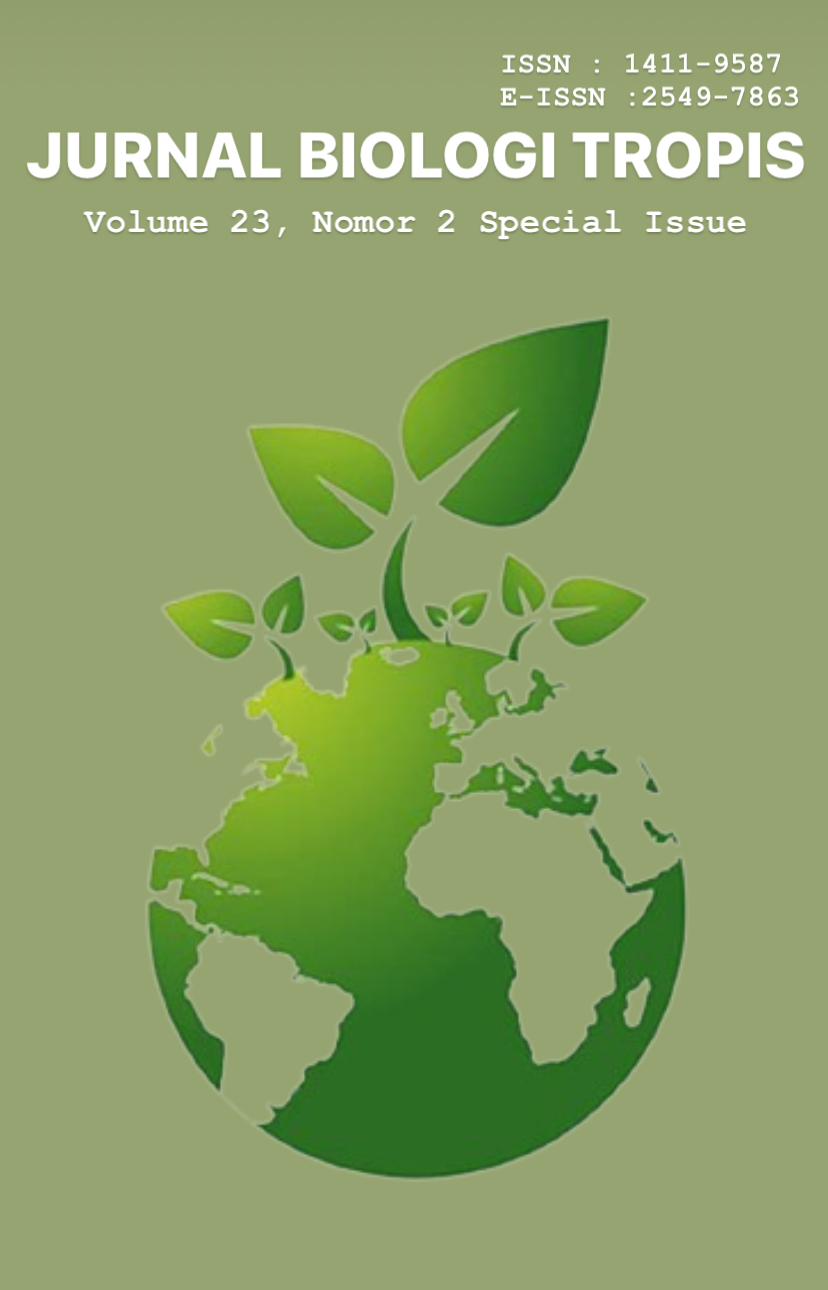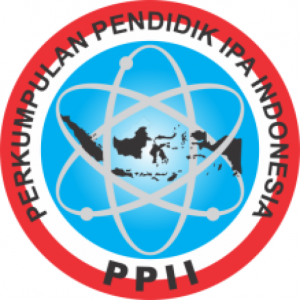
Most read articles by the same author(s)
- Rusmin Nuryadin, Syawalina Fitria, Sahrul Alim, Rhojim Wahyudi, Sadikin Amir, Niechi Valentino, Analysis of the Economic Value of Environmental Services of Mangrove Ecosystem in Cendi Manik, Sekotong District, West Lombok Regency , Jurnal Biologi Tropis: Vol. 24 No. 2 (2024): April - Juni
- Nurwahdania Nurwahdania, Andi Chairil Ichsan, Febriana Tri Wulandari, Analysis of Infiltration Rate in Community Forest Land (HKm) Wombo Rengge Kala, Dompu District, West Nusa Tenggara , Jurnal Biologi Tropis: Vol. 25 No. 1 (2025): Januari - Maret
- Andrie Ridzki Prasetyo, Niechi Valentino, Budhy Setiawan, Hasyyati Shabrina, Nurul Chaerani, Eggi Syahruanda, Spatial Distribution Pattern of Plants with Potential to Regulate Water Balance in the Babak Watershed Upstream Area , Jurnal Biologi Tropis: Vol. 25 No. 2 (2025): April-Juni
- Desti Suci Safitri, Sitti Latifah, Niechi Valentino, Estimation of Carbon Content in Mangrove Stands in The Santong Bay Mangrove Ecotourism Area Sumbawa Regency , Jurnal Biologi Tropis: Vol. 24 No. 4 (2024): Oktober - Desember
- Rima Vera Ningsih, Dini Lestari, Febriana Tri Wulandari, Niechi Valentino, Fauzan Fahrussiam, Andrie Ridzki Prasetyo, Quality of comply boards from the industrial waste of palm and bamboo , Jurnal Biologi Tropis: Vol. 24 No. 2 (2024): April - Juni
- Aditya Riizki Kurniawan, Andi Chairil Ichsan , Markum, The Carbon Stocks Estimation on The Green Belt of Mataram City , Jurnal Biologi Tropis: Vol. 23 No. 2 (2023): Special Issue
- Gde Margin Antareja, Endah Wahyuningsih, Niechi Valentino, Estimation of Carbon Reserves Above Soil Surface in Agroforestry Patterns in Mount Sasak, West Lombok District , Jurnal Biologi Tropis: Vol. 24 No. 4 (2024): Oktober - Desember
- Rifaldy Indrayana, Andi Chairil Ichsan, Endah Wahyuningsih, Carrying Capacity Assessment of the Aik Nyet Natural Tourism Area in Buwun Sejati Village, West Lombok Regency , Jurnal Biologi Tropis: Vol. 24 No. 3 (2024): July - September
- Niechi Valentino, Andrie Ridzky Prasetyo, Muhammad Anwar Hadi, Accumulation of Heavy Metal Cd and Fe in Rhizophora apiculata Stand Around Lembar Port West Lombok Regency , Jurnal Biologi Tropis: Vol. 25 No. 1 (2025): Januari - Maret
- Widya Rahayu, Andi Chairil Ichsan, Maiser Syaputra, Analysis of the Daily Behavior of Javan Gibbons (Hylobates moloch) at the Lombok Wildlife Park Ex-Situ Conservation Institute , Jurnal Biologi Tropis: Vol. 25 No. 4 (2025): Oktober-Desember
Similar Articles
- Nurseha Nurseha, Prapti Sedijani, Lalu Japa, The Effect of Egg Shell and Banana Peel Organic Fertilizer on The Growth Of Green Spinach (Amaratus tricolor L.) , Jurnal Biologi Tropis: Vol. 23 No. 4 (2023): October - December
- Ahmad Jupri, Inda Nur Cahyani, Supardiono Supardiono, Lilik Hidayati, Identification of Butterfly Larval Host Plants in the Taman Wisata Alam (TWA) Gunung Tunak, Central Lombok , Jurnal Biologi Tropis: Vol. 25 No. 2 (2025): April-Juni
- Febiayu Aloatuan, Centhya Victorin Maitimu, Application of Water Hyacinth Liquid Bio-Organic Fertilizer Using Trichoderma Sp Bio-activator on Growth and Production of Green Mustard Plants (Brassica rapa var. Parachinensis) , Jurnal Biologi Tropis: Vol. 20 No. 3 (2020): September - Desember
- Slamet Arif Susanto, Heru Joko Budirianto, Agatha Cecilia Maturbongs, Peran Vegetasi Dominan Pada Karakteristik Tanah di Lahan Bera, Kampung Womnowi, Distrik Sidey, Manokwari , Jurnal Biologi Tropis: Vol. 20 No. 2 (2020): Mei - Agustus
- Rasyadan Taufiq Probojati, Nugraheni Hadiyanti, Lia Hapsari, Assessment for Identification of Stelechocarpus burahol and Sister Species Complex of Annonaceae Family Using trnL Intron Sequences , Jurnal Biologi Tropis: Vol. 23 No. 4 (2023): October - December
- Hesti Nabila, Ahmad Raksun, Lalu Japa, Analysis of Chlorophyll and Vegetative Growth of Green Eggplant (Solanum Malongena L.) Based on NPK and Bokashi Fertilizer Application , Jurnal Biologi Tropis: Vol. 25 No. 4 (2025): Oktober-Desember
- Desi Maya Santi, Tri Mulyaningsih, Evy Aryanti, IDENTIFIKASI BAMBU DI SEMPADAN SUNGAI KEREMIT RESORT JOBEN TAMAN NASIONAL GUNUNG RINJANI LOMBOK , Jurnal Biologi Tropis: Vol. 19 No. 2 (2019): Juli - Desember
- Ni Kadek Emi Sintha Dewi, I Gede Putu Wirawan, I Ketut Suada, Morphological Identification of Balinese Caulerpa Seaweeds , Jurnal Biologi Tropis: Vol. 24 No. 2b (2024): Special Issue
- Singgih Tri Wardana, Morphological Variations of Nepenthes mirabilis (Lour.) Druce in the Peat Swamp Habitat , Jurnal Biologi Tropis: Vol. 23 No. 3 (2023): July - September
- Aulia Vina Rahmani, Agil Al Idrus, I Gde Mertha, The Structure of Mangrove Community in Regional Marine Conservation Area Gili Sulat West Nusa Tenggara , Jurnal Biologi Tropis: Vol. 23 No. 1 (2023): January - March
<< < 1 2 3 4 5 6 7 8 9 10 > >>
You may also start an advanced similarity search for this article.



























